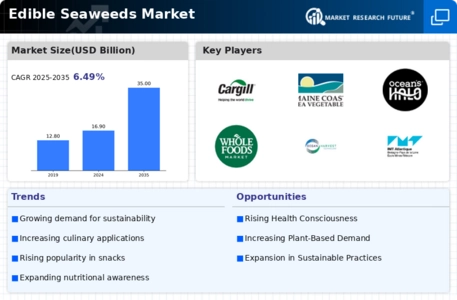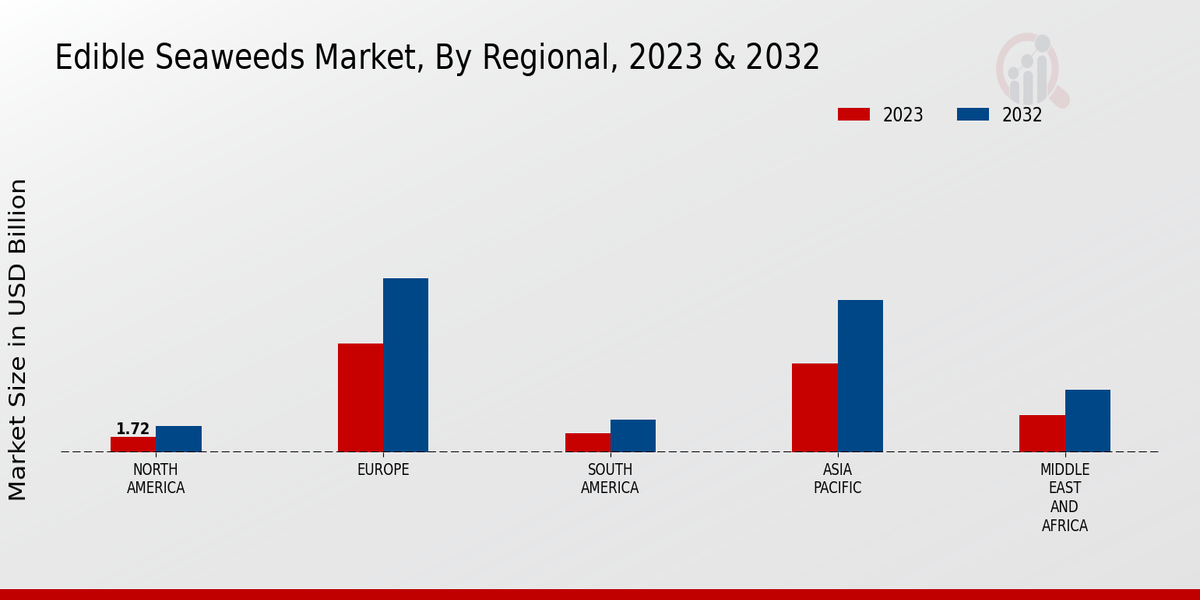Culinary Innovation
Culinary innovation plays a pivotal role in the expansion of the Global Edible Seaweeds Market Industry. Chefs and food manufacturers are increasingly incorporating seaweeds into diverse culinary applications, from gourmet dishes to everyday meals. This trend is evident in the growing popularity of seaweed-infused products, such as pasta, sauces, and snacks. The versatility of seaweeds allows for creative culinary expressions, attracting a broader consumer base. As the market evolves, innovative product development is expected to enhance the appeal of seaweeds, further driving growth in the industry. The potential for culinary exploration suggests a vibrant future for the Global Edible Seaweeds Market Industry.
Sustainable Food Source
The Global Edible Seaweeds Market Industry benefits from the growing emphasis on sustainability in food production. Seaweeds are cultivated with minimal environmental impact, requiring no freshwater or fertilizers, making them an eco-friendly alternative to traditional crops. This sustainability aspect resonates with environmentally conscious consumers and food manufacturers alike. As the global population continues to rise, the need for sustainable food sources becomes increasingly critical. The market is projected to reach 35.0 USD Billion by 2035, suggesting that the appeal of seaweeds as a sustainable food source will likely drive further investment and innovation within the industry.
Global Population Growth
The continuous growth of the global population serves as a significant driver for the Global Edible Seaweeds Market Industry. With the world population expected to reach approximately 9.7 billion by 2050, the demand for food sources is anticipated to increase substantially. Seaweeds, being a highly efficient food source, can contribute to meeting this rising demand. Their ability to grow rapidly and require minimal resources positions them as a viable solution to food security challenges. As the population expands, the Global Edible Seaweeds Market Industry is likely to experience heightened interest and investment, fostering innovation and growth.
Market Growth Projections
The Global Edible Seaweeds Market Industry is poised for substantial growth, with projections indicating a market value of 16.9 USD Billion in 2024 and an anticipated increase to 35.0 USD Billion by 2035. This growth trajectory suggests a compound annual growth rate (CAGR) of 6.87% from 2025 to 2035. The increasing consumer interest in healthy and sustainable food options, coupled with culinary innovations and the rising demand for plant-based products, contributes to this positive outlook. As the market evolves, stakeholders are likely to explore new opportunities for product development and market expansion, reinforcing the industry's growth potential.
Rising Health Consciousness
The increasing awareness of health and wellness among consumers drives the Global Edible Seaweeds Market Industry. Seaweeds are recognized for their rich nutrient profile, including vitamins, minerals, and antioxidants, which appeal to health-conscious individuals. For instance, the demand for seaweed-based snacks and supplements is on the rise, as consumers seek natural and nutritious food options. This trend is reflected in the market's projected growth, with an estimated value of 16.9 USD Billion in 2024, indicating a robust interest in incorporating seaweeds into daily diets. As health trends continue to evolve, the Global Edible Seaweeds Market Industry is likely to expand further.
Increased Demand for Plant-Based Products
The surge in demand for plant-based products significantly influences the Global Edible Seaweeds Market Industry. As consumers increasingly adopt vegetarian and vegan diets, seaweeds serve as a valuable source of plant-based nutrition. They provide essential nutrients that are often lacking in plant-based diets, such as iodine and omega-3 fatty acids. This trend is supported by the market's projected CAGR of 6.87% from 2025 to 2035, indicating a sustained interest in plant-based alternatives. The integration of seaweeds into various food products aligns with the growing consumer preference for healthier and more sustainable dietary choices, further propelling the industry forward.



















